Exocytosis is the fusion of secretory vesicles with the plasma membrane, which causes the release of vesicle contents into the extracellular space and the integration of new proteins and lipids into the plasma membrane. Exocytosis may be constitutive (occurring in all cells) or controlled (specialized cells such as neurons, endocrine and exocrine cells). Usually, but not always, a rise in the cytosolic free Ca2+ concentration triggers regulated exocytosis. In neurons and endocrine cells, a small percentage of regulated secretory vesicles are prepared to fuse with the plasma membrane in response to cell stimulation, whereas the majority are held in reserve for subsequent stimulation by linkage to a filamentous network of synapsins (in neurons) or actin (in endocrine cells) (in endocrine cells). Across cell types, kinetics and Ca2+ dependence of regulated exocytosis vary significantly. Several Ca(2+)-binding proteins are likely involved in controlled exocytosis, with synaptotagmin being necessary for rapid exocytosis at synapses. Exocytosis involves both monomeric and heterotrimeric GTP-binding proteins, however their specific function is unknown. The concept that the molecular mechanism of vesicle docking and fusion is conserved from yeast to mammalian brain is the subject of intense current investigation. The SNARE hypothesis proposes that vesicle SNAREs (synaptobrevin and homologues) facilitate docking by binding to target SNAREs (syntaxin/SNAP-25 and homologues), after which SNAPs and NSF attach to induce membrane fusion.
What is exocytosis? – Exocytosis Definition
- Exocytosis is a type of process, in which involves the movement of materials from the inside of a cell to the exterior of the cell by the use of energy.
- Exocytosis is a type of active transport because to perform this process energy is required.
- It is a vital process of plant and animal cells as it performs the opposite function of endocytosis.
- In endocytosis process, the substances enter into the cell from the external environment.
- During the exocytosis, membrane-bound vesicles carrying cellular molecules are moved into the cell membrane. The vesicles combine with the cell membrane and discharge their contents to the exterior of the cell.
- Cell use Exocytosis for the removal of waste materials, transport hormones, and proteins, for chemical signaling between cells and the construction of the cell membrane.
- The Golgi bodies, endosomes, and presynaptic neurons help in the formation of vesicles which are involved in exocytosis process.
- The vesicles combine with the cell membrane and they can be complete or temporary vesicles, depending on their function.
- Normally the cell membrane gets damaged after the endocytic pinocytosis and phagocytosis, hence the exocytic process performs to repair the cell membrane by moving proteins and lipids to the membrane for repair mechanisms.
- It is also the end-point mechanism for the transportation of protein complexes and packaging them in their destined sites and insertion to the cell membrane.
Basic Mechanism of Exocytosis
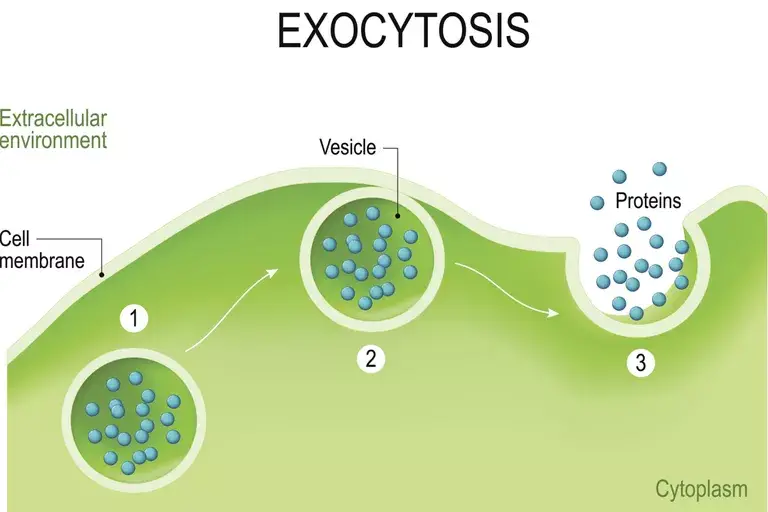
- The first step of Exocytosis involves the transportation of vesicles containing molecules from the inside of the cell to the cell membrane.
- After that, the vesicle gets attached to the cell membrane.
- During the fusion of the vesicle membrane with the cell membrane, the vesicle contents are released outside the cell.
Exocytotic Vesicles
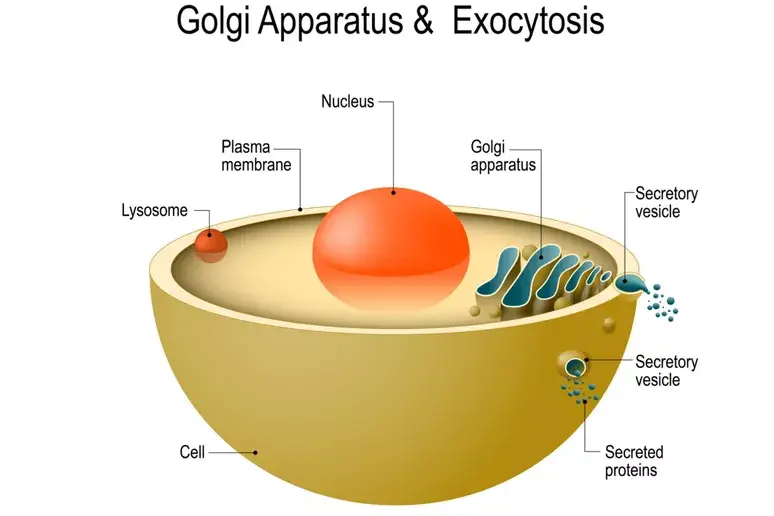
- The Exocytotic vesicles containing protein are typically originated from an organelle known as the Golgi apparatus, or Golgi complex, where newly synthesized proteins and lipids are transferred from the endoplasmic reticulum for modification and sorting.
- Once processed, the products are contained within secretory vesicles, which bud from the trans face of the Golgi apparatus.
- There are other vesicles which are fused with the cell membrane, they do not come directly from the Golgi apparatus, instead, they are formed from early endosomes, which are membrane sacs found in the cytoplasm.
- Early endosomes combine with the vesicles and are internalized by endocytosis of the cell membrane. These endosomes order the internalized material (proteins, lipids, microbes, etc.) and direct the materials to their own destinations.
- The Transport vesicles bud off from the early endosomes and send the waste material onto lysosomes for degradation while returning proteins and lipids to the cell membrane.
- Other examples of vesicles which are not derived from Golgi complexes are, the Vesicles located at synaptic terminals in neurons.
Types of Exocytosis
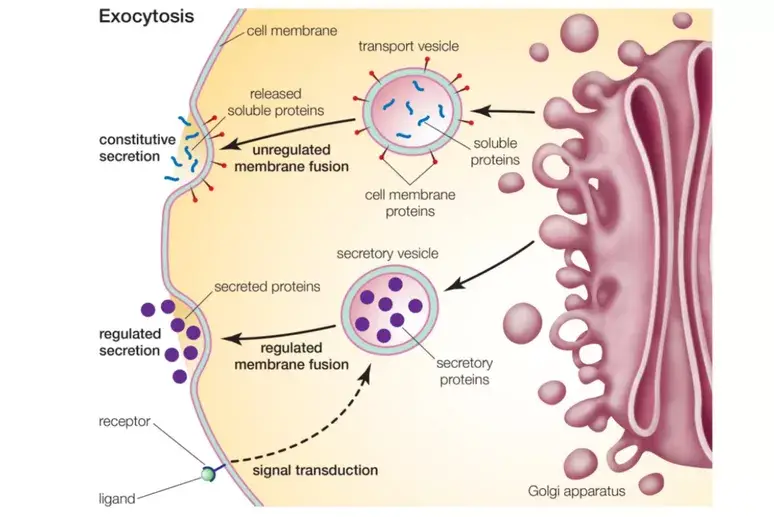
There are present three pathways within the Exocytosis processes such as;
- Constitutive exocytosis
- Regulated exocytosis
- Lysosome mediated exocytosis
1. Constructive exocytosis
This form of exocytosis involves the transport of membrane proteins and lipids to the cell membrane and the release of substances from the cell into the outside environment. This is the most prevalent pathway utilised by all bodily cells.
- Constructive exocytosis is a form of exocytosis, which is the process by which cells release materials from the interior of the cell to the exterior.
- Unlike other forms of exocytosis, which involve the release of waste or excess materials, constructive exocytosis involves the release of materials that are actively used to build structures outside the cell.
- This process is important in the development of multicellular organisms, as it allows cells to work together to create complex tissues and organs.
- Examples of constructive exocytosis include the release of collagen and other extracellular matrix components by fibroblasts, and the release of bone matrix components by osteoblasts.
- Constructive exocytosis is regulated by a variety of signaling pathways and cellular processes, including calcium signaling and cytoskeletal dynamics.
- Dysregulation of constructive exocytosis can lead to various diseases and disorders, including osteoporosis, cancer, and connective tissue disorders.
- The process of constructive exocytosis is often tightly controlled, with cells releasing specific amounts and types of materials in response to specific signals and cues.
- In some cases, cells may also actively modify and reshape extracellular structures once they have been released, through processes such as cell migration and remodeling.
- Constructive exocytosis can occur in a variety of different cell types and tissues, including bone, cartilage, skin, and connective tissue.
- Researchers are currently investigating the molecular mechanisms that regulate constructive exocytosis in order to better understand the process and develop new therapies for related diseases and disorders.
2. Regulated exocytosis
- This exocytosis process relies on the presence of extracellular signals for the expulsion of substances within vesicles.
- It commonly takes place within secretory cells and not in all cell types. These secretory cells mainly store hormones, neurotransmitters, and digestive enzymes.
- The secretion of these products from the secretory cells must be triggered by extracellular signals to start the development of secretory vesicles, which combine with the cell membrane for a long time to support the release of the cell contents out of the cell, into the exterior. After delivery, the vesicles are reformed and returned to the cytoplasm.
3. Lysosome mediated exocytosis
- This pathway involves the fusion of vesicles with lysosomes.
- Lysosomes contain different types of acid hydrolase enzymes which involve in the breakdown of waste materials, microbes, and cellular debris.
- The digested material is carried out by the lysosomes to the cell membrane and they get to fuse with the membrane, after that they release their contents into the extracellular matrix.
Steps Involve in Exocytosis – Lysosome mediated Exocytosis
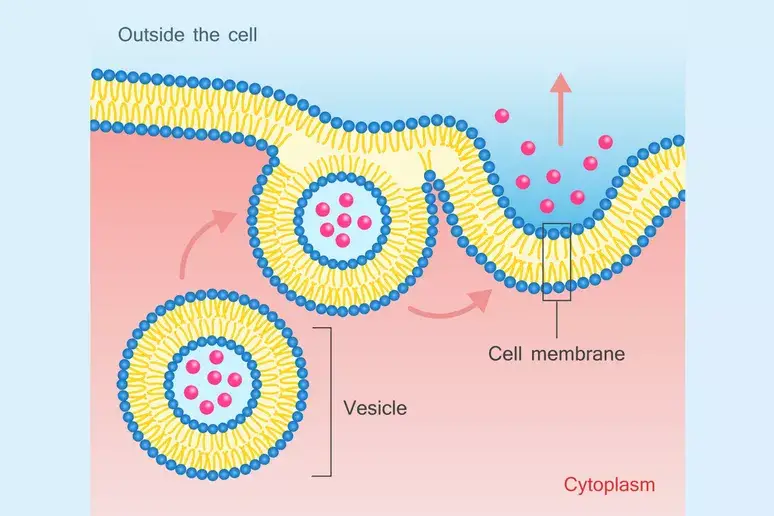
The constitutive exocytosis process takes place in four steps while the regulated exocytosis involves five steps. All of these steps are discussed below;
- Trafficking/vesicle trafficking: During this step involves the transfers of Vesicles to the cell membrane along with microtubules of the cytoskeleton and this process is powered by the motor proteins kinesins, dyneins, and myosins.
- Tethering: After transferring to the cell membrane, it is linked to and pulled into contact with the cell membrane.
- Docking: In this step, the vesicle membrane is get attached to the cell membrane. The attachment process involves the merging of phospholipid bilayers of the both vesicle membrane and cell membrane.
- Priming: This step takes place during regulated exocytosis. It involves specific modifications of certain cell membrane molecules which are required for signaling processes that will trigger the exocytosis process to take place.
- Fusion: There are involving two types of fusion that are taking place in exocytosis such as; complete fusion and kiss-and-run fusion. During complete fusion, a fusion occurs between the vesicle membrane and cell membrane as a result a fusion pore is formed, which permits the contents of the vesicle to be discharged as the vesicle becomes part of the cell membrane.ATP provides the energy which is required to separate and fuse the lipid membranes. During the kiss-and-run fusion, a fusion pore is formed when the vesicle temporarily fuses with the cell membrane. After that, it releases the contents through the fusion pore to the exterior of the cell. Then, the vesicle pulls away from the cell membrane and reforms before retreating to the interior of the cell.
Functions of Exocytosis – WWhat is the purpose of exocytosis?
- Secretion of molecules: One of the primary functions of exocytosis is to secrete molecules from the cell. Cells use exocytosis to release various substances, including hormones, enzymes, and neurotransmitters, to communicate with other cells and regulate physiological processes.
- Removal of waste: Exocytosis also allows cells to remove waste and other unwanted materials from the cell. Lysosomes, which are organelles that contain digestive enzymes, use exocytosis to release their contents to break down cellular debris and recycle cellular components.
- Membrane repair: Exocytosis can also be used to repair or replace damaged portions of the cell membrane. By fusing with the plasma membrane, vesicles can provide new lipids and proteins to replace those lost or damaged in the membrane.
- Cell growth and differentiation: Exocytosis plays a role in cell growth and differentiation by delivering membrane and cytoplasmic proteins to the cell surface. This is important for the formation of new tissues during development and for the maintenance of tissues in adults.
Overall, exocytosis is a fundamental process that allows cells to communicate with each other, maintain homeostasis, and carry out essential physiological functions.
Exocytosis Examples
There are present numerous examples of Exocytosis, all of them are discussed below;
1. Exocytosis in the Pancreas
- The islets of Langerhans in the pancreas produce the hormones insulin and glucagon which are stored in secretory granules and released by exocytosis when signals are received.
- If the glucose concentration in the blood is started increase, insulin will be released from islet beta cells and it will trigger the cells and tissues to take up glucose from the blood.
- If the glucose concentrations become low, glucagon is secreted from islet alpha cells. This will lead the liver to convert stored glycogen to glucose. Glucose is then released into the blood causing blood-glucose levels to rise.
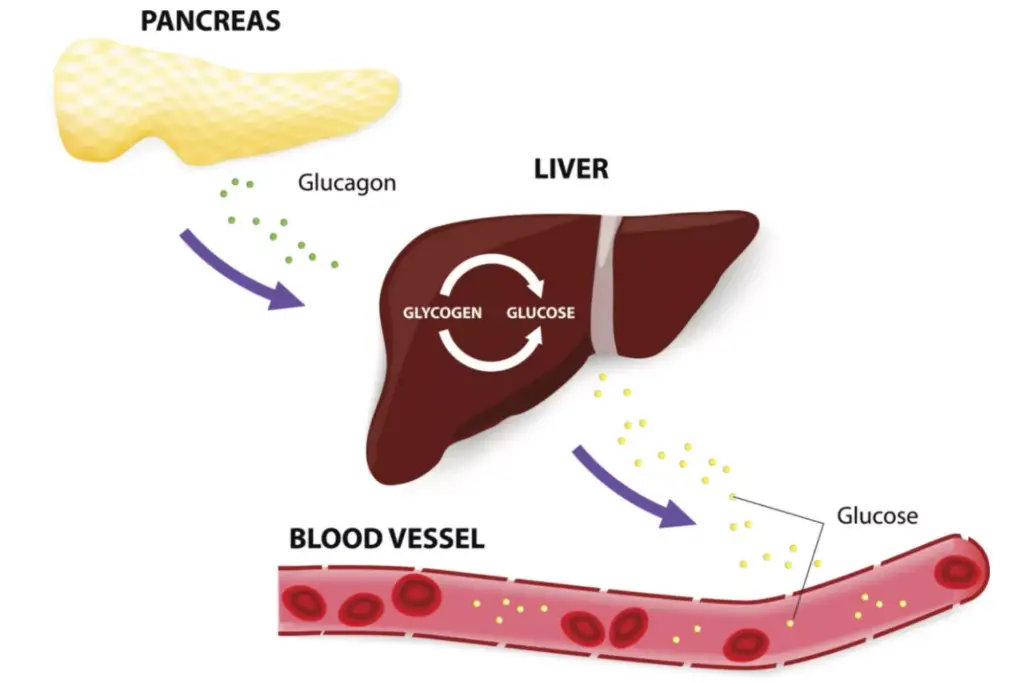
2. Exocytosis in Neurons
- The Synaptic vesicle exocytosis takes place within the neurons of the nervous system.
- The communication system of Nerve cells involves the passage of electrical or chemical (neurotransmitters) signals from one neuron to the next. The transmission of these Neurotransmitters is accomplished by the exocytosis process.
- The synaptic vesicles help to transport these chemical messages from nerve to nerve. Synaptic vesicles are basically a type of membranous sacs which are formed by endocytosis of the plasma membrane at presynaptic nerve terminals.
When would a cell need to perform exocytosis?
Cells may need to perform exocytosis in several situations, including:
- Secretion of molecules: Cells use exocytosis to secrete various molecules such as hormones, neurotransmitters, and enzymes to communicate with other cells and regulate physiological processes.
- Removal of waste: Exocytosis is also used by cells to remove unwanted materials and waste products, such as the contents of lysosomes that break down cellular debris.
- Membrane repair: Cells may use exocytosis to repair or replace damaged portions of the cell membrane by fusing vesicles with the plasma membrane to provide new lipids and proteins.
- Cell growth and differentiation: Exocytosis plays a role in cell growth and differentiation by delivering membrane and cytoplasmic proteins to the cell surface, important for the formation of new tissues during development and for the maintenance of tissues in adults.
- Response to environmental stimuli: Exocytosis may be used by cells to respond to environmental stimuli, such as the release of histamine from mast cells in response to an allergen.
Overall, cells perform exocytosis to maintain homeostasis, communicate with other cells, and carry out essential physiological functions.
What types of materials are expelled from cells during exocytosis?
During exocytosis, a variety of materials can be expelled from cells. Some common examples include:
- Hormones: Hormones are signaling molecules that are produced by cells in one part of the body and released into the bloodstream or extracellular fluid to affect cells in other parts of the body.
- Enzymes: Enzymes are proteins that catalyze chemical reactions in the body. Some enzymes are released from cells via exocytosis to act on molecules outside the cell.
- Neurotransmitters: Neurotransmitters are chemical messengers that allow nerve cells to communicate with one another. They are released from synaptic vesicles in nerve terminals via exocytosis.
- Waste products: Cells produce a variety of waste products as part of their normal metabolic processes. These waste products can be expelled from the cell via exocytosis.
- Secretions: Many cells produce and secrete substances such as mucus, digestive enzymes, and sweat. These secretions can be expelled from the cell via exocytosis.
Overall, exocytosis is an essential process that allows cells to communicate with one another, respond to their environment, and maintain homeostasis.
What is the difference between endocytosis and exocytosis? – endocytosis vs exocytosis
Exocytosis and endocytosis are both cellular processes involved in the movement of materials in and out of the cell. Here are some of the key differences between these two processes:
- Direction of movement: Exocytosis involves the movement of materials from inside the cell to the outside, while endocytosis involves the movement of materials from outside the cell to the inside.
- Types of materials transported: Exocytosis is typically used to transport molecules such as proteins, lipids, and carbohydrates, while endocytosis is used to transport various materials including nutrients, cell surface receptors, and pathogens.
- Method of transport: Exocytosis involves the fusion of vesicles with the plasma membrane, which releases the contents of the vesicles into the extracellular space. Endocytosis involves the formation of vesicles from the plasma membrane, which enclose the materials to be transported and bring them into the cell.
- Regulation: Both exocytosis and endocytosis are tightly regulated processes, with the rate of transport being influenced by various factors such as cell signaling, energy availability, and cellular metabolism.
- Types of endocytosis: There are several different types of endocytosis, including phagocytosis (the engulfment of large particles), pinocytosis (the uptake of small molecules and fluid), and receptor-mediated endocytosis (the uptake of specific molecules bound to cell surface receptors).
- Role in cellular processes: Exocytosis is important for processes such as secretion, neurotransmitter release, and the maintenance of the cell membrane. Endocytosis plays a key role in nutrient uptake, receptor signaling, and immune defense.
- Dysregulation and disease: Dysregulation of both exocytosis and endocytosis can lead to a variety of diseases and disorders, including neurodegenerative diseases, cancer, and immune disorders.
Exocytosis Video
References
- Morgan A. Exocytosis. Essays Biochem. 1995;30:77-95. PMID: 8822150.
- Padawer, J. (1998). Exocytosis. Encyclopedia of Immunology, 849–856. doi:10.1006/rwei.1999.0224
- https://www.sciencedirect.com/science/article/pii/B0123868602002574
- https://www.thoughtco.com/what-is-exocytosis-4114427
- https://www.technologynetworks.com/immunology/articles/endocytosis-and-exocytosis-differences-and-similarities-334059
- https://www.mechanobio.info/what-is-the-plasma-membrane/what-is-membrane-trafficking/what-is-exocytosis/
- https://www.geeksforgeeks.org/exocytosis/
- https://flexbooks.ck12.org/cbook/ck-12-biology-flexbook-2.0/section/2.16/primary/lesson/exocytosis-and-endocytosis-bio/
- https://microbenotes.com/exocytosis-definition-process-and-types-with-examples/
- https://courses.lumenlearning.com/suny-wmopen-biology1/chapter/endocytosis-and-exocytosis/
- https://teaching.ncl.ac.uk/bms/wiki/index.php/Exocytosis
- Text Highlighting: Select any text in the post content to highlight it
- Text Annotation: Select text and add comments with annotations
- Comment Management: Edit or delete your own comments
- Highlight Management: Remove your own highlights
How to use: Simply select any text in the post content above, and you'll see annotation options. Login here or create an account to get started.